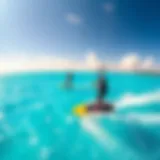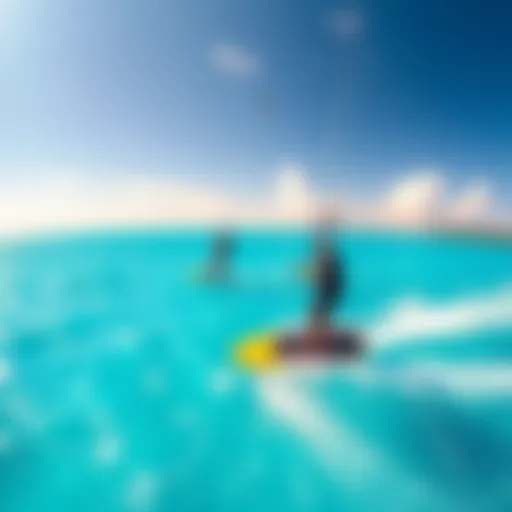The Essential Guide to Kite Pumps in Kiteboarding
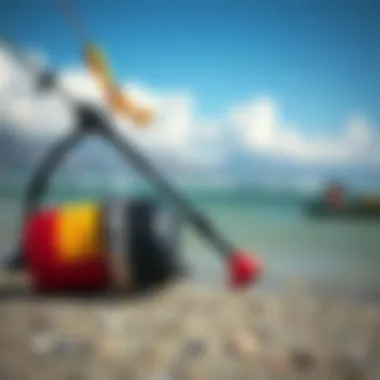
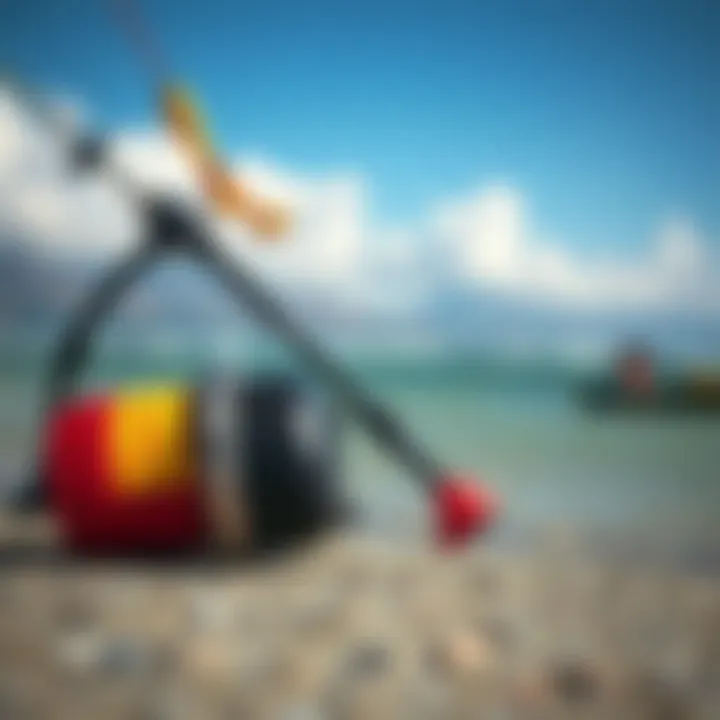
Intro
Kiteboarding is not just a sport; it’s a dance between wind and water, where every movement, every decision impacts the ride. An essential component of this exhilarating experience is the kite pump, often overlooked but instrumental in kite performance. Without a proper inflation, a kite's ability to soar is compromised, and therefore, understanding the nuances of kite pumps becomes paramount for both newcomers and seasoned players. This guide aims to illuminate the various aspects of kite pumps, equipping enthusiasts with the knowledge to make informed choices, thereby enhancing their kiteboarding experiences.
Gear and Equipment
Essential Kiteboarding Gear for Beginners
Starting in kiteboarding can feel a bit like diving into the deep end, especially when it comes to gear. A novice should prioritize getting the right equipment. The kite pump, naturally, is one of those essentials. It’s not just about inflating; it’s about setting the stage for performance. A double-action pump can save time by inflating the kite on both the upstroke and downstroke, a perfect pick for beginners trying to maximize effort and efficiency.
Alongside the kite pump, other key gear includes a reliable kite, a sturdy board, and a harness. When starting off, look for an inflatable kite that offers stability and ease of control. As for the board, a larger one can be more forgiving and help in learning balance. Investing in a harness that fits well is crucial too, as it will hold you comfortably while riding the waves.
Advanced Equipment for Experienced Riders
For those who have been riding the winds for a while, the choice of gear becomes sartorial art. Advanced kite pumps might come equipped with features like pressure gauges, ensuring optimal inflation. The material of the pump hose and the design can make a world of difference in durability and performance.
Furthermore, experienced riders often invest in specialized kites tailored for specific conditions. Whether it’s a bigger kite for light wind or a smaller one for stronger gusts, knowing your riding style and local conditions is key. Additionally, high-performance boards crafted from lightweight composites can elevate maneuvers and provide agility that complements expert skill.
Techniques and Tips
Safety Practices for Kiteboarding
Practicing kiteboarding without a solid grasp of safety can be a ticket to trouble. Always wear a helmet and a buoyancy aid to provide protection from unexpected falls or gusty winds. Familiarize yourself with the "kite zone" at your chosen riding spot; knowing where it’s safe to launch and land your kite is key in avoiding accidents.
Equally important is communication with fellow kiters. Hand signals can often go a long way, and keeping an eye on each other not only helps promote a safer environment but also fosters camaraderie among kiting enthusiasts.
Training Techniques to Improve Your Skills
Enhancing kiteboarding skills requires both practice and effective techniques. Start with body drag exercises to improve your control and awareness in the water. This not only builds confidence but also sharpens your reactions to varying conditions. As your skills progress, incorporating jumps and tricks gradually will help develop a more intimate connection with the kite.
Seek feedback from experienced riders, and don’t shy away from joining a local kiting club or community to share knowledge and insights. Riding with others can fundamentally change your perspective and accelerate your learning journey.
"Know your kite and learn to listen to it. Every flutter tells a story, and understanding that is half the battle."
Taking the time to learn about kite pumps and related equipment can be as rewarding as the sport itself. With the right gear, safety practices, and continuous training, kiteboarding can become not just a hobby but a lifelong passion.
Understanding Kite Pumps
Kite pumps are often the unsung heroes of kiteboarding, playing a vital role in the performance of the sport. When you think about kiteboarding, your mind might drift to the thrill of riding the waves or soaring above the water. However, without properly inflated kites, those experiences are more of a dream than a reality.
Understanding kite pumps goes beyond merely knowing how to inflate a kite. It involves grasping the nuances of air pressure and volume that directly impact a kite’s responsiveness and stability during flight. A kite that is over-inflated or under-inflated can lead to poor performance, making it essential for riders to choose their pumps wisely and handle them with care.
Defining the Kite Pump's Purpose
At its core, the purpose of a kite pump is simplicity—inflate your kite quickly and efficiently. When you look at it this way, it might feel a bit mundane. But, the functionality of a kite pump is integral. A good pump helps achieve the right pressure in your kite, ensuring that it maintains its shape and can handle the winds you’ll be riding in.
A lot comes into play with the pump's design and operation. Some pumps deliver air with one stroke, while others do it with both strokes (double action). Choosing the right pump not only eases the hassle but cranks up your readiness on the water. Buying a sturdy and reliable pump should be high on your priority list if you want to enjoy the sport without disappointment.
The Role of Inflation in Kite Performance
Inflation and kite performance are intrinsically linked, as they determine how well the kite behaves in various wind conditions. It’s almost like trying to bake a cake; if you don’t have the right ingredients in the correct proportions, the final product can turn out poorly. The same goes for a kite—if it’s not properly inflated, it won’t fly as it should.
When a kite is inflated to its ideal pressure, it translates to better lift, stability, and responsiveness. For instance, during high winds, a properly inflated kite can maintain its form and allow the rider to maneuver effectively. On the flip side, a kite that is lacking air can become floppy and unmanageable, resulting in less control and a higher likelihood of crashing. Even a small amount of pressure lost can lead to noticeable changes in performance, underscoring the significance of inflation.
"Proper inflation is the backbone of kite performance; it’s what gives you the confidence to challenge the winds."
Thus, understanding kite pumps is not just a technicality—it's essential for anyone looking to elevate their kiteboarding experience. As you delve into selecting a pump, keep in mind that its effectiveness in achieving optimal inflation is paramount. In other words, take your time to learn the ins and outs of your kite pump, as it can profoundly influence your overall performance on the water.
Types of Kite Pumps
Understanding the various types of kite pumps is essential for kiteboarders looking to maximize their experience on the water. By knowing the distinct features, benefits, and drawbacks of each type, riders can choose the one that best suits their needs and practices. Depending on the rider's skill level, preferred riding style, and the frequency of use, the right pump can greatly influence the efficiency of kite inflation and the overall performance of the kite during a session.
Single Action Pumps
Single action pumps are a straightforward choice for many kiteboarders, particularly newcomers to the sport. They work by inflating the kite on the upstroke only, pushing air into the kite with each stroke. A major benefit of single action pumps is their ease of use. They're typically lighter and can be more portable, making them perfect for those who travel frequently. However, they require more effort and a higher number of strokes to fully inflate a kite compared to other types.
When using a single action pump, consider the following aspects:
- Portability: The lightweight design is ideal for beach sessions where every ounce counts.
- Stamina: More strokes are needed, which may lead to fatigue if the kite needs to be inflated rapidly.
- Cost-Effectiveness: Generally, single action pumps are more affordable than their counterparts, making them a solid option for beginners.
Double Action Pumps
Double action pumps are a step up in terms of efficiency and performance. They inflate the kite during both the upstroke and the downstroke, significantly reducing the time and effort needed to achieve a fully inflated kite. As a result, experienced kiteboarders often prefer this type due to its speed and effectiveness.
Here are some things to keep in mind about double action pumps:
- Speed: This is a primary advantage, allowing kiteboarders to spend less time pumping and more time on the water.
- User Fatigue: The additional air intake may lead to quicker inflation, but it also demands a bit more physical effort per stroke compared to single action pumps.
- Design: Generally, double action pumps may be bulkier; however, many models are designed to be compact and easily transportable.
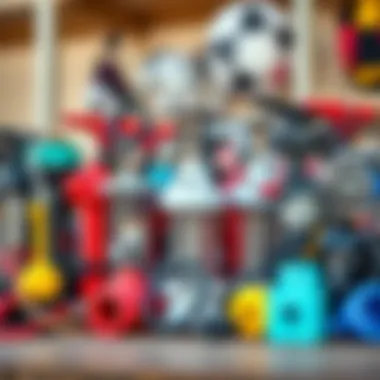
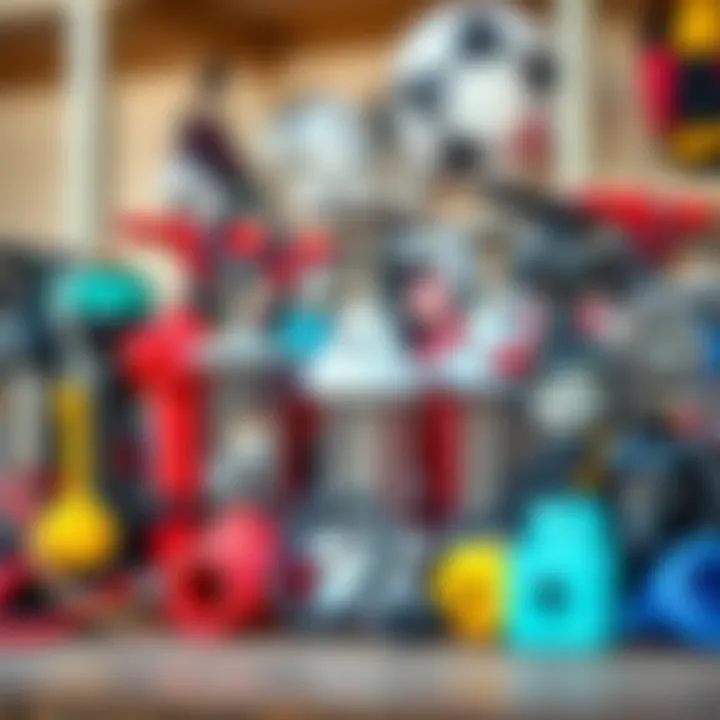
Electric Pumps
For those who prefer convenience, electric pumps are the future of kite inflation. These innovative devices take the manual labor out of the equation, allowing users to inflate their kites with the push of a button. They are particularly beneficial for larger kites or setups that require more air volume.
Key considerations for electric pumps include:
- Efficiency: Electric pumps are often the fastest option, making them ideal for groups or sessions where quick setup is essential.
- Cost: Typically, they are more expensive than manual pumps, and the investment can be significant depending on the brand and features.
- Power Source: Riders need to consider where the electricity will come from. Most electric pumps can plug into a car battery or a portable power bank, which can add a layer of convenience but may also introduce limitations in remote locations.
In summary, the choice between single action, double action, and electric pumps will depend on personal preferences and the specific demands of the rider. By evaluating the key elements of each type, kiteboarders can make informed decisions that enhance their kiteboarding adventures.
Key Features to Consider
When selecting a kite pump, certain features can significantly affect the efficiency of inflating your kite and, consequently, your overall experience in the water. Understanding these features will help you make an informed choice that aligns with your specific needs, whether you're a weekend warrior or a seasoned kiteboarding enthusiast.
Pump's Volume Capacity
The volume capacity of a kite pump refers to how much air it can move in a single stroke. This measurement is crucial because it directly influences how fast you can inflate your kite. Generally, a pump with a higher volume capacity means fewer pumps are needed to reach your desired pressure, ultimately saving time.
Choosing the right capacity involves considering the size of your kite. For instance, larger kites typically require more air, thus benefiting from a pump designed to handle greater volumes.
- Small Kites: Pumps with lower volume capacities may suffice, as these kites require less air to inflate.
- Large Kites: Opt for high-volume pumps, which can inflate bigger kites quickly and efficiently.
With a good pump handling 1.5 to 2 liters per stroke, you can squirt out your air quickly. Novice kiters often struggle with small pumps when attempting to inflate larger kites. It’s like trying to fill up a bathtub with a garden hose; it simply won't work efficiently.
Pressure Gauge Importance
Another critical feature in kite pumps is the pressure gauge. A pressure gauge indicates the kite's internal pressure in psi or bar, providing a visual representation of how fully inflated your kite is. Relying on feel or guesswork can lead to over-inflated or under-inflated kites, affecting performance negatively.
Here’s why the pressure gauge matters:
- Performance Optimization: Proper inflation enhances kite responsiveness, stability, and lift, allowing you to ride smoother and higher.
- Safety Consideration: Over-inflation can lead to kite damage or, worse, accidents on the water.
Keeping an eye on the pressure gauge is akin to monitoring the fuel gauge in your car—both are essential for ensuring your gear performs optimally.
Nozzle Compatibility
Last but not least, nozzle compatibility is a feature that kiteboarders often overlook. A pump needs to fit seamlessly onto the kite's valve to ensure efficient air transfer without leaks. Most pumps come equipped with several nozzle attachments for different kinds of valves, but compatibility can vary based on the pump and kite brand.
Before making a purchase, consider the following:
- Valve Types: Familiarize yourself with common valve styles, such as Boston and One-Pump systems, which may require specific nozzle adapters.
- Ease of Use: Quick-connect nozzles can simplify the inflation process, saving you time and amidst the chaos of prepping your kite.
Finding a pump that matches your kite’s valves isn't just convenience; it enhances the entire experience, allowing you to focus on the fun rather than wrestling with your pump.
In summary, the right features can make or break your kiteboarding experience. From volume capacity to pressure gauges and nozzle compatibility, each element plays a crucial role in ensuring your kite is inflated correctly and ready for action.
Choosing the Right Kite Pump
Selecting the ideal kite pump can feel like navigating a maze; there are numerous factors to consider that can make a real difference in your kiteboarding experience. An appropriate pump assists not only in inflating your kite effectively but also in maintaining the overall performance and longevity of your gear. Choosing wisely not only saves you a few extra bucks in the long run but also enhances the overall kiteboarding experience, ensuring you catch those perfect waves without a hitch.
Assessing Your Needs
Every kiteboarder comes to the sport with different needs. Assessing those needs is the first step toward picking the right pump.
- Skill Level: If you’re just starting out, you might want to look for something user-friendly and straightforward. On the other hand, experienced riders might need a pump that can handle high-pressure inflation more efficiently.
- Kite Size: A large kite requires a higher volume capacity, while smaller kites might need something more compact. Consider the size of the kite(s) you generally use.
- Frequency of Use: If you hit the water every weekend, durability is key. Choose a pump that can withstand regular use and also be easily stored without damage.
- Physical Condition: Some pumps require a bit more elbow grease than others—be sure to choose one that matches your physical capabilities.
Recommendations for Beginners
As a beginner, it’s best to keep things simple. You don’t need all the bells and whistles. Here are a few recommendations:
- Single Action Pumps: These are great for those just starting out. They inflate air as you push down, making it straightforward. Easy to use and less tiring!
- Electric Pumps: For those who want to skip the workout, electric pumps can be a game changer. They can fill up your kite in no time, although keep in mind that they require a power source.
- Budget Options: Look for basic models from well-rated brands that won’t break the bank. You can always upgrade later when you’ve gained more experience.
Best Options for Experienced Riders
If you’ve got a bit of experience under your belt, consider these options:
- Double Action Pumps: These pumps allow air to flow in both upstroke and downstroke, efficiently speeding up the process of inflation. They are ideal for seasoned riders who want to hit the water as quickly as possible.
- High-Pressure Pumps: These pumps can inflate your kite to a higher pressure than standard pumps, which may improve performance and response time. They work well for larger kites.
- Integrated Manometers: Having a pressure gauge can help ensure that your kite is inflated to the proper specifications. This is key for optimal performance, and many experienced riders now swear by it.
"Choosing the right kite pump is not just about convenience—it influences the whole kiteboarding experience."
In sum, the choice of a kite pump requires a thoughtful approach, balancing various factors to match personal needs and preferences. With the right pump in hand, riders can inflate their kites efficiently and enjoy their time on the water even more.
The Importance of Pump Maintenance
Maintaining your kite pump is not merely a chore; it’s essential for extending its lifespan and safeguarding the performance of your kite. Ignoring maintenance can lead to decreased efficiency, resulting in frustrating situations out on the water. A kite pump that isn't properly maintained may deliver inadequate pressure, making your kite unruly and unpredictable in the air. After all, when you’re dependent on a gust of wind, the last thing you want is it to be thwarted by an underperforming pump.
Regular Cleaning Procedures
Cleaning your kite pump shouldn’t be an optional task. Grit, sand, and even saltwater can infiltrate the pump during use, so a routine cleaning schedule is highly beneficial. Think about it: every session you have with the pump, you’re potentially inviting these particles into your pump's mechanism.
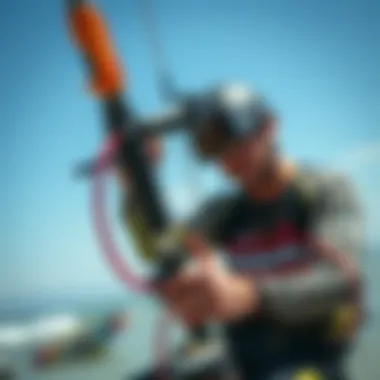
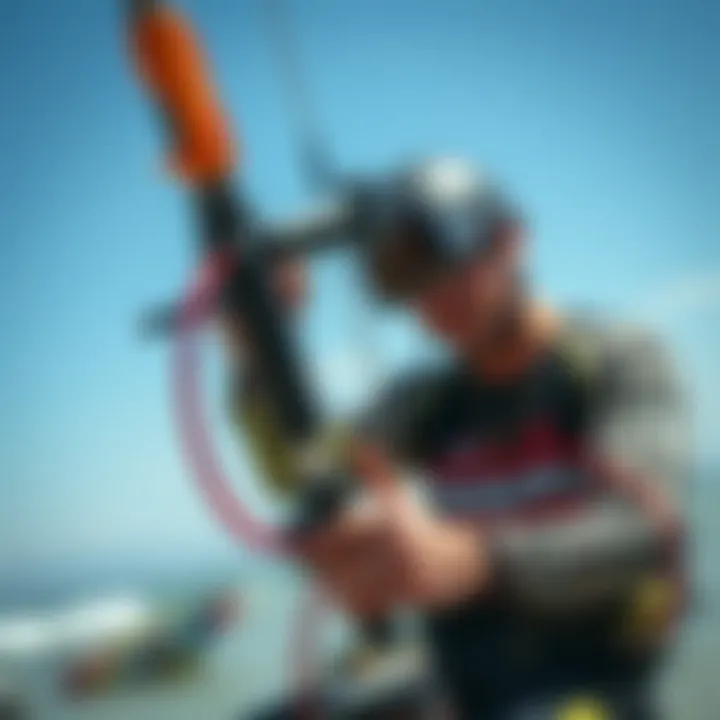
To clean your pump:
- Rinse with Fresh Water: After each use, especially in salty or sandy conditions, rinse the exterior and the nozzle with fresh water. This simple step helps prevent corrosion and blockages that can stem from residue.
- Disassemble When Necessary: Periodically, especially after heavy use, disassemble the pump to check for internal wear and tear. Dust off any particles and inspect for signs of damage.
- Use Mild Soap: For more stubborn stains or residue, a gentle soap can do wonders. Just make sure to rinse thoroughly afterward, as soap residue can also interfere with performance.
Regular cleaning not only keeps your pump working well but also reinforces good habits that will carry over into the maintenance of other gear.
Storage Practices for Longevity
How you store your kite pump can significantly impact its longevity. Improper storage can lead to degradation and malfunction over time. Here are some strategies for keeping your pump in top shape:
- Cool, Dry Place: Store your pump in a cool, dry area. Extreme temperatures and humidity can deteriorate rubber seals and other materials.
- Avoid Compression: Don’t leave heavy objects resting on the pump. This can cause permanent deformation or stress on the components, resulting in air leaks down the line.
- Keep it Upright: If possible, store the pump upright or in a vertical position. This helps maintain the shape and integrity of the pump's tubes and hoses.
- Cap Nozzles: If your pump has multiple nozzles, cap or cover them during storage to prevent dust and debris from accumulating inside.
Taking these thoughtful steps in storage can mean the difference between a pump that serves you well for years and one that falters mid-session.
"A well-cared-for pump is your silent partner in achieving the ideal kite performance."
In summary, the significance of maintaining your kite pump cannot be overstated. It's an integral part of your gear, and giving it the attention it requires can ensure your kiteboarding experience remains smooth and exhilarating.
Troubleshooting Common Issues
In kiteboarding, the functionality of your kite pump can make the difference between a thrilling experience and a frustrating outing. Understanding common issues and knowing how to troubleshoot them is crucial for maintaining optimal performance during kiteboarding sessions. Addressing these problems promptly ensures that your kite remains fully inflated and ready for action, ultimately enhancing your overall experience on the water.
Identifying Air Leaks
One of the most common issues kiteboarders face is air leaks in the inflation system. These leaks can occur at various points—most frequently at the valve connection or in the material of the kite itself. Identifying air leaks is essential, as even a small loss of pressure can significantly hinder a kite's performance.
To pinpoint a leak, start by visually inspecting the valve and seams. Look for signs of wear or damage where the fabric joins. Often, a simple method involves immersing the inflated kite in water and observing for any bubbles; these indicate exits of air. If you locate a leak, repair should be attempted as soon as possible. Duct tape can be a temporary fix for minor issues, but for a more reliable solution, consider using kite repair patches or glue designed specifically for the material of the kite.
Dealing with Stuck Valves
Stuck valves can cause considerable headaches during a kiteboarding session. They can prevent proper inflation or deflation, leading to potential struggles on the water. Recognizing the symptoms of a stuck valve is pivotal. If you notice that your pump isn't working as it should, or if the valve doesn't close or open smoothly, you've probably got a stuck valve on your hands.
To remedy this, start by cleaning the valve area with fresh water to remove debris or sand that may have accumulated. Applying a silicone lubricant might also help in freeing the mechanism. If that doesn't do the trick, you might have to replace the valve entirely. Always keep an eye on manufacturer specifications, as using the wrong type of valve could cause further issues later on.
Maintenance for Extended Durability
To avoid frequent troubles with your pump and kite, regular maintenance is critical. Simple care practices can significantly extend the lifespan and performance of your equipment. After each use, it's wise to rinse the pump and valves with freshwater to eliminate sand or salt residue.
When it comes to storage, always store the pump in a cool, dry place rather than leaving it out in the sun or in humid conditions. Sunlight can cause plastic components to degrade over time, while humidity can facilitate mold and corrosion. A well-maintained pump will ensure that you can grab it and head out without hassle, maximizing your time on the water.
Remember, effective troubleshooting goes beyond fixing what's broken; it involves a proactive approach to care and maintenance.
In summary, understanding how to identify air leaks, how to deal with stuck valves, and performing regular maintenance are essential components of keeping your kite pump in top shape. By being proactive, you ensure a better experience in kiteboarding, enabling you to focus on what truly matters—the ride!
Inflation Techniques for Optimal Performance
When it comes to kiteboarding, the inflation process of a kite is not just a simple task; it is crucial for optimizing overall performance on the water. Proper inflation ensures that the kite maintains its shape, responsiveness, and stability, which directly influences how it navigates the wind. A well-inflated kite performs better in various conditions, allowing the rider to harness the wind effectively and achieve impressive maneuvers.
Efficient Pumping Strategies
Implementing smart pumping techniques can make a world of difference. Here are some strategies to enhance your inflation process:
- Pre-inflation Setup: Ensure everything is ready before starting. Lay your kite flat, clear of jagged edges and debris to avoid punctures.
- Two-Stage Pumping: Begin with a single-action technique to get a nice initial volume of air in. Once it’s inflated to a good shape, switch to double-action pumping for maximum pressure.
- Use Your Body Weight: Leverage your weight on the pump for better force, rather than relying solely on your arms. This can speed up the inflation process.
- Pumping Rhythm: Develop a consistent rhythm while pumping; this not only improves efficiency but also builds muscle memory, allowing you to inflate your kite faster over time.
Using these strategies can help kiteboarders inflate their kites with ease, saving both time and energy on the beach.
Timing Your Inflation
Timing is everything, not just in kiteboarding but also in the pre-flight process. The when and how of inflation can set the tone for the entire session.
- Environmental Awareness: Pay attention to wind conditions. For light winds, inflate earlier to avoid drifting away, while in stronger winds, it’s better to wait until you’re ready to launch.
- Assistant Help: If possible, have a buddy help. They can hold the kite against wind while you pump, ensuring a quicker inflation without complications.
- Inflate While Active: Inflate your kite close to the launch zone and when the wind is steady. Doing this can help visualize how the kite will behave in real-time conditions.
“Getting your timing right ensures you’re not wasting time and energy on the beach when you could be riding the waves!”
Understanding these timing nuances allows kiteboarders to be more efficient and prepared, minimizing downtime and maximizing ride enjoyment. A well-timed inflation can turn an ordinary kiteboarding day into a memorable adventure.
Impact of Technology on Kite Pumps
The evolution of kite pumps is no small matter in the realm of kiteboarding. As it turns out, the advancements in technology have significantly changed the way kiteboarders inflate their kites, translating directly into better performance on the water. Innovations have ensured that pumps are not just functional but also cater to the diverse needs of riders at all skill levels.
From smart electric pumps to ergonomic designs that reduce the effort needed to get a kite inflated efficiently, technology plays an integral role in enhancing the overall experience and performance. The benefits are manifold:
- Speed: New designs allow for faster inflation, getting you on the water without wasting precious time.
- Efficiency: Improved pumps can achieve required pressure quicker, meaning they're not just inflating air but providing a stable kite performance.
- User-Friendly Designs: Modern pumps often boast an ergonomic design, which can ease the physical strain associated with inflating larger kites.
As kiteboarding continues to grow as a sport, the demand for higher performance equipment aligns with an ever-growing market for better and more efficient kite pumps. Let's take a closer look at some specific innovations that showcase this trend.
Innovations in Pump Design
The design landscape for kite pumps has transformed dramatically in recent years. Older models often required significant effort to achieve desirable inflation levels, but technological advancements have streamlined this process. One noticeable change is the creation of lightweight materials, such as reinforced plastics and composites, which make pumps easier to handle without sacrificing durability. This has allowed manufacturers to produce models that are not only portable but also efficient.
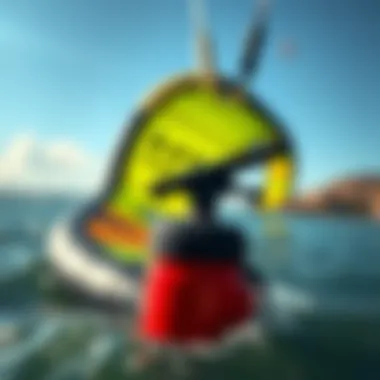
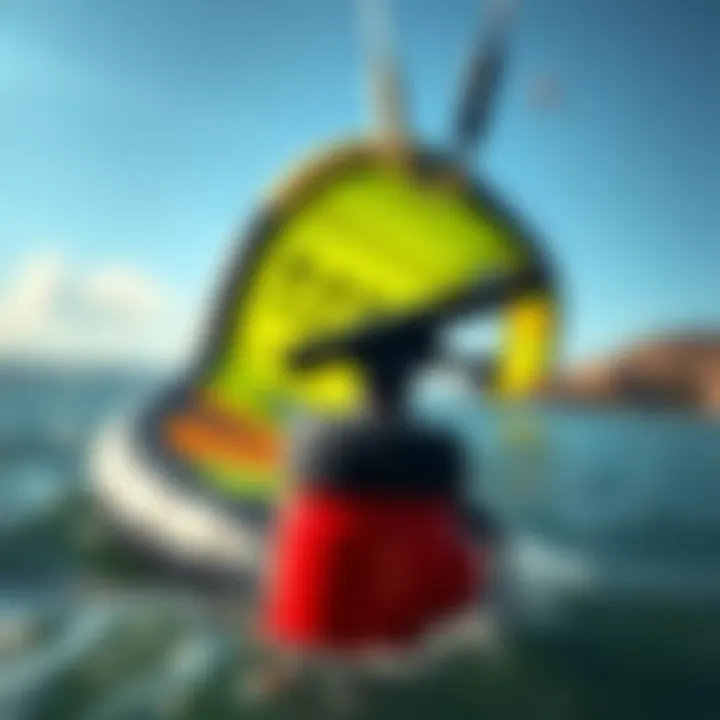
- Ergonomic Handles: These now incorporate grip patterns that minimize slippage, making it easier for users to maintain their hold while pumping.
- Folding Mechanisms: Some newer models can fold down for easier storage, vital for those who frequently travel or have limited space.
- Enhanced Chamber Designs: Innovations like multi-chamber constructions enable an increase in air volume pumped with each stroke, reducing overall pumping time.
These design improvements directly support kite performance by ensuring that the kite reaches the necessary inflation pressure quickly and easily, which can really come in handy during high wind conditions.
Integration with Electronic Systems
Just as technology changes, we must also consider how pumps are integrating with electronic systems. Electric pumps have gained popularity, particularly among those who prefer a more leisurely approach to their pre-ride rigging. With settings that allow users to choose the desired pressure, electric kite pumps take the guesswork out of the equation.
"Electric pumps can inflate a typical kite in just a few minutes, giving riders more time to enjoy the water."
Here are some key features that make electric pumps appealing:
- Automatic Shut-off: Once the desired pressure is achieved, these pumps automatically stop inflating, preventing over-inflation and potential damage to the kite.
- Battery Operated: Many are portable and rechargeable, so they can be used at remote locations where power outlets aren’t available.
- User Interface: Modern electric pumps often come with a control panel that allows for easy pressure adjustments and monitoring.
However, while electric pumps are convenient, not every kiteboarder may find them essential. Many still prefer manual pumps for the tactile connection they provide to the gear and for the sense of preparation it affords. But there is no denying that as technology progresses, electric pumps offer intriguing options for those looking to maximize efficiency and focus more on the ride.
Comparative Analysis of Popular Brands
In the world of kiteboarding, gear selection can make or break your experience. When it comes to kite pumps, choosing the right one is just as crucial as selecting your kite or board. Understanding the nuances between brands allows kiteboarders to find a pump that matches their personal style and performance requirements. A comparative analysis of popular brands also sheds light on the diverse features available, helping enthusiasts navigate their options wisely. Ultimately, a well-informed choice could enhance your time on the water, ensuring that each session is as exhilarating as possible.
Brand A: Features and Limitations
Brand A's pump is known for its robust construction and user-friendly design. With a double action pumping system, it delivers air during both the up and down strokes, making inflation quicker and less strenuous. The pressure gauge is another notable feature, giving you real-time data on the kite’s inflation. However, it does have some limitations. The size of the pump can be a bit cumbersome for some, and it might not fit easily into smaller bags. Additionally, while the price point is competitive, some users feel it may not offer the same longevity as pricier alternatives.
Brand B: Performance Review
When it comes to performance, Brand B's pump stands out. Users rave about its lightweight design, allowing for easy transport during kite trips. The model incorporates a quick-lock nozzle, which ensures a secure fit on the kite valve and prevents accidental disconnections during inflation. Users report that they can inflate their kites in record time, thus spending more minutes on the water rather than prepping on land. However, it's not all sunshine; some have complained about the pump's durability, mentioning the nozzle can wear out too quickly if not handled carefully. Balancing performance with care is key.
Brand C: Price vs. Value Analysis
Brand C tends to ride the middle ground between price and value, making it a popular choice among both beginners and seasoned kiteboarders. This pump combines essential features without breaking the bank. With a generous volume capacity, it effectively inflates a variety of kites quickly. The design is straightforward, lacking some bells and whistles, but it gets the job done, earning a reputation for reliability.
One aspect to consider is that while it offers decent reliability, some users might prefer to invest a little more for a pump that has more advanced features. Therefore, when evaluating Brand C, it’s about understanding your personal needs. The question to ponder is whether the trade-off between cost and quality meets your kiteboarding aspirations.
"A good kite pump can be the unsung hero of a kiteboarder’s setup, ensuring that your kite is ready to deliver thrilling sessions on the water."
In the pursuit of the perfect kite pump, it's essential to weigh these brands against your individual requirements and expectations. Each one has its strengths and pitfalls, which can influence your overall kiteboarding experience. The key is to align your choice with your riding style, frequency of use, and personal preferences.
Sustainable Materials and Eco-friendly Options
In today's world, where environmental concerns are at the forefront of many discussions, kiteboarding enthusiasts are increasingly looking towards sustainable materials and eco-friendly options for their gear. Kite pumps are no exception. The shift towards sustainability is crucial, not only for the health of our planet but also for the longevity and performance of the equipment we rely on during our adventures.
Importance of Sustainable Manufacturing
Sustainable manufacturing in kite pump production involves using materials that minimize environmental impact and ensuring that the manufacturing processes adhere to practices that reduce waste and pollution. The kiteboarding industry has begun recognizing that the materials used in pumps—like plastics and composites—can harm the environment if not sourced responsibly. By adopting greener materials, companies can contribute to preserving the ecosystems that kiteboarders enjoy.
This approach leads to several significant benefits:
- Reduced Carbon Footprint: Sourcing raw materials sustainably can lower greenhouse gas emissions throughout the production cycle.
- Biodegradability: Using materials that can decompose reduces landfill waste, meaning less pollution and strain on waste management systems.
- Enhanced User Awareness: Brands that focus on sustainability often share their missions with consumers, creating a community of environmentally conscious riders. This may encourage more riders to consider the ecological impact of their gear selections.
As kiteboarding continues to grow in popularity, sticking to sustainable practices will help ensure that future generations can also enjoy this thrilling sport without damaging the beautiful places it takes place.
Exploring Eco-friendly Pump Brands
When it comes to finding eco-friendly kite pumps, not all brands are created equal. Various manufacturers are stepping up to the plate, offering products that not only perform well but also tread lightly on the environment. Here are a few noteworthy options:
- Slingshot Sports
Known for their commitment to sustainability, Slingshot Sports employs responsible sourcing and production methods in their pump designs. - Airush
This brand focuses on utilizing recycled materials in their products, including kite pumps, aiming to lessen their dependence on non-renewable sources. - Cabrinha
A progressive brand that integrates eco-friendly practices from the production floor through to the final product. They are making strides toward reducing plastic waste.
When selecting a pump, look for labels or certifications indicating sustainable practices, such as those that meet certain eco-labeling standards. Keep an eye out for brands that disclose their manufacturing processes—transparency is usually a good indicator of a firm’s commitment to sustainability.
In sum, as kiteboarding continues to evolve, so too does the opportunity to embrace more sustainable practices when it comes to gear. Choosing eco-friendly kite pumps not only benefits the environment but also enhances your experience on the water, knowing that you're making a positive impact.
The Future of Kite Pump Technology
The realm of kiteboarding is an ever-evolving landscape, driven by continuous advancements in technology. At the heart of this evolution lies the kite pump, a seemingly simple tool that plays a pivotal role in the overall performance of a kite. As kiteboarding gains popularity, the demand for efficient, lightweight, and user-friendly pumps is increasing. Understanding the future of kite pump technology is essential to both manufacturers and users alike. This section delves into emerging trends and predictions that are shaping the next generation of kite pumps.
Emerging Trends in Pump Design
Recent design philosophies have prioritized user experience and efficiency. One notable trend is the incorporation of lightweight materials. Electric pumps with advanced inflation monitoring systems are on the rise, significantly decreasing the physical effort required during setup. Think batteries that last through those long days at the beach, allowing for rapid inflation and deflation without the strain of manual pumping. Also, these pumps often use sensors to gauge the pressure within the kite, applying just the right amount of air.
Another direction focuses on the ergonomics of the pump handle and hose. The ideal design has an adjustable handle height that caters to different users, reducing strain on the back during prolonged use. Additionally, pumps designed to minimize air loss through better valves contribute to efficiency, ensuring that air remains inside the kite until it's time to hit the water.
Furthermore, brands are experimenting with modular pump systems that allow for interchangeable parts, tailoring the pump to individual needs or conditions. Riders can swap between short and long hoses depending on their kite size or style, enhancing versatility in various environments. This ensures that performance enhancement is at the forefront of any design.
Predictions for Kiteboarding Equipment
The forecasting of kiteboarding equipment trends offers a glimpse into what the future holds. Given the rapid pace of innovation, we can expect kite pumps to become an integral part of a kite's overall tech ecosystem. As kiteboarding continues to merge with technology, we may see integration with smartphones through Bluetooth, allowing riders to track their pump's performance metrics. This could involve monitoring the pressure, volume, and battery levels of electric pumps directly from a mobile app.
In addition, the drive toward sustainability in manufacturing will heavily influence kite pumps. As kiteboarding enthusiasts increasingly prioritize eco-conscious choices, manufacturers are likely to explore biodegradable materials and production methods that minimize waste. Pumps made from recycled plastics might become the norm, reflecting a collective commitment to lowering the environmental footprint of the sport.
Research from the kiteboarding community shows that riders prefer pumps that align with their values, namely performance and sustainability.
Moreover, our rides could benefit from smart technology, where pumps fit into the broader narrative of kiteboard tech that includes sensors on the kite itself for real-time performance feedback. This system could adjust the pump's functions autonomously, ensuring optimal pressure and responsiveness on the go.
In summary, the future of kite pump technology stands to greatly enhance the kiteboarding experience, making it more accessible, efficient, and aligned with the values of modern consumers. Whether it's lightweight builds, smart features, or eco-responsibility, the developments on the horizon promise exciting times ahead for kiteboarding enthusiasts.
